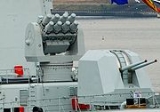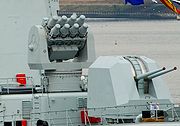
HQ-7
Encyclopedia
The HongQi 7 or HQ-7 (FM-80) is a short-range air defense missile
. The missile is deployed on both ships and land-based vehicles. China
revealed the export version, FM-80, in the 1989 Dubai
Aerospace Show. Unit cost is around $162,000 per launcher and $24,500 per missile.
. At the time, China's military equipment was seriously lagging behind the Soviets in quality, and Beijing sought Western assistance to modernize its military. Countries such as the US, UK, Israel
, Italy
, France
, Germany
and Australia
responded by providing China with military sales and technology transfers, either openly or covertly.
China imported some land and sea versions of the Thomson-CSF Crotale missile
in 1978-1979 for evaluation. The Thomson-CSF R-440 Sea Crotale SAM and Thomson-CSF TSR 3004 Sea Tiger E/F-band radar were installed on the Peoples Liberation Army Navy (PLAN) destroyer #109 Kaifeng (Type 051 Luda-class) and destroyer #112 Harbin (Type 052 Luhu-class). The Peoples Liberation Army (PLA) found the Crotale system to be superior to the HQ-61 SAM, and instructed the 2nd Aerospace Academy (now the China Academy of Defense Technology) to reverse-engineer the Crotale, the 23rd Institute to reverse-engineer the radar and fire control system, and the 206th Institute to develop ground-based vehicle carriers for the SAM.
China was able to produce copies of the Crotale (HQ-7) missile for testing in 1983. It was certified for serial production in 1986-1988. China promoted an export version, FM-80, at the 1989 Dubai Aerospace Show. Through the 1990s, the HQ-7 was deployed at Peoples Liberation Army Air Force (PLAAF) bases, on PLA vehicles, and PLAN ships. It was PLAN's standard ship-based air-defense SAM for over a decade, until the introduction of the more capable, longer-range HQ-9.
A typical land-based HQ-7 battalion consists of:
Each Operational Section consists of:
Each Support/Maintenance Section consists of:
 The HQ-7 became PLAN's standard short-range air-defense SAM in the 1990s. Even the latest Type 054 Frigate uses the Naval version of HQ-7. The typical configuration is one 8-cel launcher, with stores of reload missiles in multiples of 8 (8, 16, 24). Earlier versions required manual re-loading, while the latest have an auto re-loader that can be retracted under the deck.
The HQ-7 became PLAN's standard short-range air-defense SAM in the 1990s. Even the latest Type 054 Frigate uses the Naval version of HQ-7. The typical configuration is one 8-cel launcher, with stores of reload missiles in multiples of 8 (8, 16, 24). Earlier versions required manual re-loading, while the latest have an auto re-loader that can be retracted under the deck.
The Naval HQ-7 uses a Type 360S
E/F-band Doppler radar with a detection range of 18.4 km, connected to the ZJK-4 (Thomson-CSF TAVITAC) combat management system. The system is capable of processing up to 30 targets, and tracking 12 targets simultaneously.
Missile
Though a missile may be any thrown or launched object, it colloquially almost always refers to a self-propelled guided weapon system.-Etymology:The word missile comes from the Latin verb mittere, meaning "to send"...
. The missile is deployed on both ships and land-based vehicles. China
People's Republic of China
China , officially the People's Republic of China , is the most populous country in the world, with over 1.3 billion citizens. Located in East Asia, the country covers approximately 9.6 million square kilometres...
revealed the export version, FM-80, in the 1989 Dubai
Dubai
Dubai is a city and emirate in the United Arab Emirates . The emirate is located south of the Persian Gulf on the Arabian Peninsula and has the largest population with the second-largest land territory by area of all the emirates, after Abu Dhabi...
Aerospace Show. Unit cost is around $162,000 per launcher and $24,500 per missile.
History
In the late 1970s, China joined the Western powers in an informal alliance against the Soviet UnionSoviet Union
The Soviet Union , officially the Union of Soviet Socialist Republics , was a constitutionally socialist state that existed in Eurasia between 1922 and 1991....
. At the time, China's military equipment was seriously lagging behind the Soviets in quality, and Beijing sought Western assistance to modernize its military. Countries such as the US, UK, Israel
Israel
The State of Israel is a parliamentary republic located in the Middle East, along the eastern shore of the Mediterranean Sea...
, Italy
Italy
Italy , officially the Italian Republic languages]] under the European Charter for Regional or Minority Languages. In each of these, Italy's official name is as follows:;;;;;;;;), is a unitary parliamentary republic in South-Central Europe. To the north it borders France, Switzerland, Austria and...
, France
France
The French Republic , The French Republic , The French Republic , (commonly known as France , is a unitary semi-presidential republic in Western Europe with several overseas territories and islands located on other continents and in the Indian, Pacific, and Atlantic oceans. Metropolitan France...
, Germany
Germany
Germany , officially the Federal Republic of Germany , is a federal parliamentary republic in Europe. The country consists of 16 states while the capital and largest city is Berlin. Germany covers an area of 357,021 km2 and has a largely temperate seasonal climate...
and Australia
Australia
Australia , officially the Commonwealth of Australia, is a country in the Southern Hemisphere comprising the mainland of the Australian continent, the island of Tasmania, and numerous smaller islands in the Indian and Pacific Oceans. It is the world's sixth-largest country by total area...
responded by providing China with military sales and technology transfers, either openly or covertly.
China imported some land and sea versions of the Thomson-CSF Crotale missile
Crotale missile
The Crotale EDIR is an all-weather short-range anti-air missile, which can be used to intercept low-flight anti-ship missiles and aircraft...
in 1978-1979 for evaluation. The Thomson-CSF R-440 Sea Crotale SAM and Thomson-CSF TSR 3004 Sea Tiger E/F-band radar were installed on the Peoples Liberation Army Navy (PLAN) destroyer #109 Kaifeng (Type 051 Luda-class) and destroyer #112 Harbin (Type 052 Luhu-class). The Peoples Liberation Army (PLA) found the Crotale system to be superior to the HQ-61 SAM, and instructed the 2nd Aerospace Academy (now the China Academy of Defense Technology) to reverse-engineer the Crotale, the 23rd Institute to reverse-engineer the radar and fire control system, and the 206th Institute to develop ground-based vehicle carriers for the SAM.
China was able to produce copies of the Crotale (HQ-7) missile for testing in 1983. It was certified for serial production in 1986-1988. China promoted an export version, FM-80, at the 1989 Dubai Aerospace Show. Through the 1990s, the HQ-7 was deployed at Peoples Liberation Army Air Force (PLAAF) bases, on PLA vehicles, and PLAN ships. It was PLAN's standard ship-based air-defense SAM for over a decade, until the introduction of the more capable, longer-range HQ-9.
HQ-7 (FM-80) Land-based
The HQ-7 SAM is used by PLA and PLAAF for short-range air-defense. At some PLAAF bases, the HQ-7 is deployed in hardened shelters. The PLA has mounted the HQ-7 on towed trailers.A typical land-based HQ-7 battalion consists of:
- 3 x Operational Sections
- 1 x Support / Maintenance Section
Each Operational Section consists of:
- 1 x Search Unit with:
- E/F-band Doppler Search Radar (18.4 km range)
- Target processing unit, can process 30 targets & track 12 targets simultaneously
- Wired network to firing units
- IFF & radio section
- 3 x Firing Units, each with:
- Optical aiming system
- 4 x 40 kW generators
- 4-cel or 8-cel missile launcher
- J-band tracking radar (17 km range)
- TV tracking system (15 km range)
- IR localiser
- Target processing unit
- Wired network
- IFF & radio stations
Each Support/Maintenance Section consists of:
- 10 support vehicles
- Maintenance group
HQ-7 (FM-80) Self-Propelled
The 206th Institute has developed a 4x4 self-propelled version of the HQ-7. 4 x HQ-7 SAMs and a tracking radar system is mounted on a 4x4 vehicle, or towed vehicle.HQ-7 (FM-80) Naval

The Naval HQ-7 uses a Type 360S
Type 360 Radar
The Type 360 is an air/surface search radar manufactured by Yangzhou Marine Electronic Instruments Research Institute / No. 723 Institute and is reportedly based on Selenia RAN-10S / SPS – 774...
E/F-band Doppler radar with a detection range of 18.4 km, connected to the ZJK-4 (Thomson-CSF TAVITAC) combat management system. The system is capable of processing up to 30 targets, and tracking 12 targets simultaneously.
HQ-7A (FM-90)
In 1998, the China National Precision Machinery Import and Export Corp (CNPMIEC) produced an improved HQ-7 with faster and longer-range missiles, with an IR-tracking camera. This version received the export designation FM-90.HQ-7 Specs
- Missile dimensions: (length) 3.00 m; (diameter) 0.156 m; (wingspan) 0.55 m
- Launch weight: 84.5 kg
- Operating altitude: 30~5,000 m (HQ-7/FM-80); 15~6,000 m (FM-90)
- Minimum operating range: 500 m (HQ-7/FM-80); 700 m (FM-90)
- Max operating range: HQ-7/FM-80 {8,600 m (400 m/s target); 10,000 m (300 m/s target); 12,000 m (slow flying targets)}; FM-90: 15,000 m to all targets
- Speed: Mach 2.3 (750 m/s)
- Guidance: Command + electro-optical tracking
- Warhead: HE-FRAG with proximity fuse
- Radar detecting range: 18.4 km (HQ-7/FM-80); 25 km (FM-90)
- Radar homing range: 17 km (HQ-7/FM-80); 20 km (FM-90)

